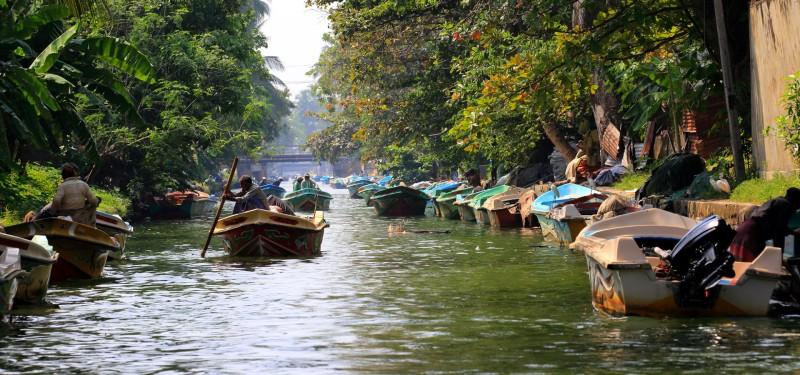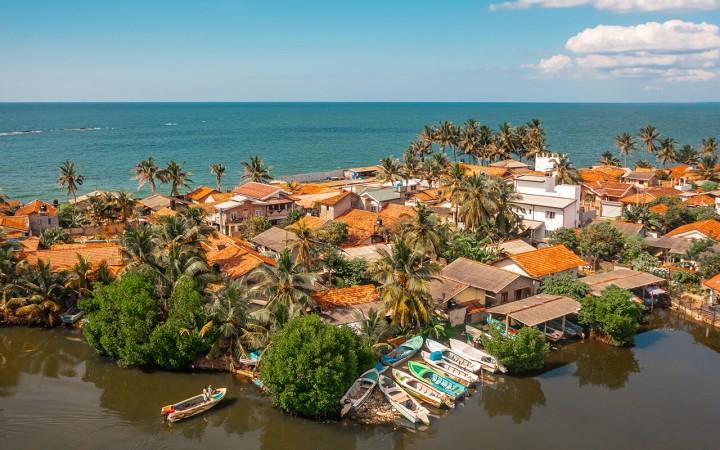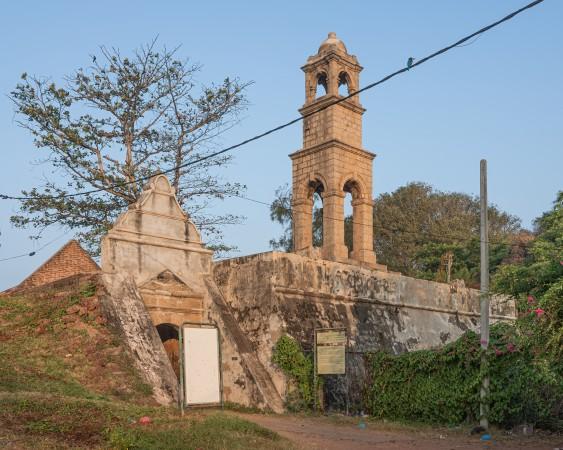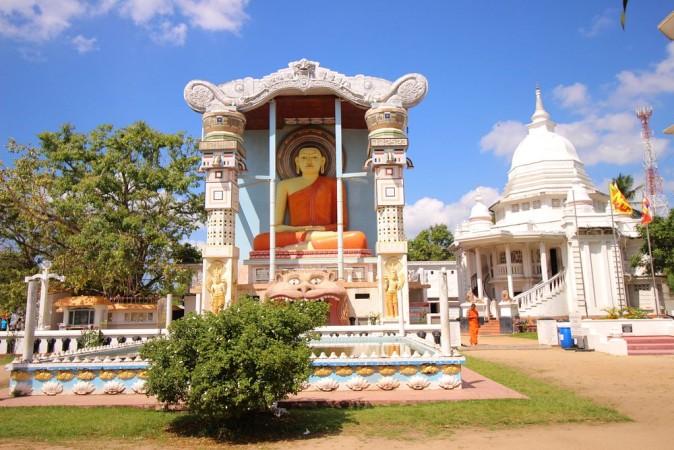Negombo travel - Sri Lanka, Asia
Negombo is a lively coastal city located just 38 kilometers from Colombo and 9 kilometers from Bandaranaike International Airport, making it a convenient destination for travelers. The city is home to a diverse mix of Sinhalese, Tamils, and Muslims, though it's best known for its strong Roman Catholic heritage, earning it the nickname "Little Rome."
Historically, Negombo was a key port for the Portuguese, who established a fort and influenced the area's culture and religion. The Dutch later expanded the city's canal system and left behind colonial architecture, which still stands today.
Negombo is famous for its long, sandy beaches and thriving fishing industry, where visitors can explore the local fish market or join fishing trips. The nearby lagoon, rich in biodiversity, offers birdwatching and eco-tour opportunities, while water sports like diving and snorkeling add adventure to this picturesque coastal town.
Population: Estimate 140,000 people (as of 2024)
Economy: Negombo’s economy is primarily driven by tourism and fishing, making it a fascinating destination for travelers eager to experience local industries. Its close proximity to Bandaranaike International Airport makes Negombo a convenient stop for many tourists, offering a range of accommodations from budget guesthouses to luxury beach resorts. Fishing is a major part of the town’s economy, with the bustling fish market providing a glimpse into local life—you can observe morning fish auctions or enjoy fresh seafood at numerous restaurants. You can also take boat trips to explore the lagoon and observe traditional fishing practices.
Landmarks: Negombo Beach, Negombo Lagoon,St. Mary's Church, Hamilton Canal, Negombo Fish Market, Dutch Fort, Angurukaramulla Temple, Rukmani Devi Park
Sri Lanka

Overview of Negombo
History & Cultural Influence
Negombo has a rich history that has shaped its unique cultural identity. Before European colonization, Negombo was an important port for the Sinhala monarchy, known for its safe lagoon waters, which facilitated external trade. The Portuguese arrived in the early 1500s, building a fort and establishing control over the cinnamon trade while introducing Catholicism, a faith that still thrives in the city today. The Dutch took over in 1646, strengthening the fort and developing an intricate canal system that boosted Negombo's status as a commercial hub. British colonization further connected Negombo to the rest of the island with the 1907 railway expansion, encouraging plantation growth.
The city’s cultural legacy reflects its colonial past—often referred to as "Little Rome," it boasts a large Catholic population and numerous colonial-era churches. Architectural landmarks from the Dutch and Portuguese periods, including the fort and canals, still stand, while the fishing traditions of the Karava community persist with distinctive catamaran-style boats. Today, Negombo is a vibrant, multicultural city, blending its historical roots with a modern economy driven by tourism and fishing, attracting visitors with its beaches, historical landmarks, and thriving fish market.
Interaction with The Locals
When visiting Negombo, you will find the locals warm and welcoming, reflecting the city’s long-standing connection to tourism. Negombo is a vibrant mix of cultures, with a majority of Sinhalese residents, alongside significant Muslim and Tamil communities, making for a rich and diverse experience. Known as "Little Rome" due to its large Catholic population, the city also embraces a blend of religious influences, including Buddhism, Hinduism, and Islam.
Many locals, especially those working in tourism, speak English, so communication is generally easy. Whether you're exploring the fish market or strolling along the beach, you'll find people eager to engage, share stories, and offer insights into their way of life. The atmosphere is relaxed and friendly, with locals showing patience and hospitality towards visitors, making for a positive and enriching experience.

Negombo Lagoon - © gather
Top Attractions in Negombo
Negombo offers a blend of cultural and natural attractions that captivate travelers. Visitors can relax on the scenic Negombo Beach, explore the vibrant Negombo Fish Market, or take a peaceful boat tour through the biodiverse Negombo Lagoon. Historical sites like the Dutch Fort and St. Mary’s Church showcase the city’s rich colonial and Catholic heritage, making it a must-visit destination.
Negombo Beach
Location: Western coast of Negombo
Negombo Beach stretches along the golden sands of Sri Lanka’s western coastline, bordered by swaying palm trees. It’s a favorite spot for both locals and visitors, offering water sports like kite surfing and windsurfing. Whether you’re enjoying a peaceful day soaking up the sun or taking an evening stroll along the beach, you’ll find plenty of seaside restaurants and shops nearby to explore.
Negombo Lagoon
Location: East of Negombo city
The serene Negombo Lagoon is teeming with biodiversity and surrounded by lush mangroves. Boat tours offer a closer look at the local fishing communities and wildlife, with opportunities to see various bird species and aquatic life. This tranquil lagoon plays a key role in sustaining the local ecosystem and fishing traditions.
St. Mary's Church
Location: Main Street, Negombo
St. Mary's Church stands as a striking symbol of Negombo’s rich Catholic heritage. Known for its beautiful architecture, the church features elaborate ceiling frescoes and colorful stained glass windows. It is a prominent cultural and religious landmark, highlighting the deep roots of Christianity in the city.
Dutch Fort
Location: Near the fish market, Negombo
Originally constructed by the Portuguese and later fortified by the Dutch in the 17th century, Negombo’s Dutch Fort is a relic of the city’s colonial past. Although only parts of the fort remain, including sections of the wall and gates, it offers an intriguing glimpse into Negombo’s history as a key colonial trading post.
Negombo Fish Market
Location: North of the Dutch Fort
As one of Sri Lanka’s largest fish markets, the Negombo Fish Market offers a lively and authentic experience. Visitors can watch as fishermen bring in their daily catch and witness the bustling trade of seafood. The market is known for its vibrant atmosphere and a close-up look at traditional fish drying methods.
Angurukaramulla Temple (Temple of the Red Ants)
Location: Temple Road, Negombo
This vibrant Buddhist temple is home to a massive 6-meter Buddha statue and vividly painted murals depicting Buddhist history. The temple’s architecture is eye-catching, with a dragon-mouth entrance that sets it apart from other religious sites. It’s a peaceful yet culturally rich site, reflecting the diverse religious influences in Negombo.

St. Mary's Church - © gather
Must-Try Dishes in Negombo
Prawn Kottu
Negombo adds its own flair to Sri Lankan street food with Prawn Kottu. This dish features shredded roti stir-fried with fresh prawns, vegetables, and spices on a sizzling iron griddle. It’s a flavorful, filling meal that showcases Negombo’s abundant seafood and love for bold, hearty dishes.
Fish Ambul Thiyal
A local favorite in Negombo, Fish Ambul Thiyal is a sour and tangy tuna curry made with goraka, a souring fruit that gives it a distinct flavor. This dish reflects the city’s coastal roots, where fresh fish plays a central role in everyday cuisine.
Crab Curry
Famous for its fresh seafood, Negombo is known for its rich, spicy Crab Curry. Lagoon crabs are simmered in a creamy coconut milk-based curry, offering a delicious, spicy bite that’s often enjoyed in beachside shacks or seaside restaurants.
String Hoppers with Dhal Curry
String hoppers, delicate steamed rice noodles, are a popular dish in Negombo, often served with a smooth, savory dhal curry. This meal is a breakfast staple, offering a light yet flavorful taste of Sri Lankan tradition.
Pol Sambol
A meal in Negombo wouldn’t be complete without Pol Sambol, a zesty coconut relish made with grated coconut, onions, chili, and lime. It’s a must-have side dish that adds a punch of fresh, tropical flavor to nearly every local dish.

Prawn Kottu - © gather
Weather in Negombo: Best Time to Visit
Temperature
Negombo maintains relatively consistent warm temperatures throughout the year:
Average daily highs range from 29-33°C (84-91°F)
Average daily lows range from 23-26°C (73-79°F)
April tends to be the hottest month, with average highs around 33°C (91°F)
September is typically the coolest month, with average highs around 30°C (86°F)
Rainfall
Negombo experiences two monsoon seasons that influence rainfall patterns:
The driest months are January and February, with only 2-5 days of rain on average
October is usually the wettest month, with around 29 days of rain
The southwest monsoon brings increased rainfall from May to August
The northeast monsoon affects the region from October to January
Best Time to Visit
The ideal time to visit Negombo is generally considered to be:
December through April, which offers pleasant weather and minimal rainfall
January to March is particularly favorable, with settled weather and abundant sunshine
Tourism peaks in July, August, and January, so expect higher prices and larger crowds during these months.

Dutch Fort - © A.Savin
Festivals & Local Celebrations
Duwa Passion Play
When: Easter Week (March or April)
Experience one of Sri Lanka’s oldest and most renowned Catholic traditions—the Duwa Passion Play. Taking place in the fishing village of Duwa, just off Negombo, this 400-year-old pageant re-enacts the passion of Jesus Christ. With over 250 performers, including local TV and film stars, it’s a unique blend of religious devotion and theatrical drama that captivates audiences. Visitors will witness dramatic performances staged throughout Holy Week, making it a must-see event for those in Negombo during Easter.
Fisherman’s Festival
When: Late July
Negombo’s rich fishing heritage comes alive during the annual Fisherman’s Festival. Celebrating the town’s close connection to the sea, this event is perfect for seafood lovers and cultural enthusiasts alike. Visitors can explore exhibitions of deep-sea fish like shark, lobster, and prawns, enjoy cultural performances showcasing traditional fishing methods, and, of course, sample the freshest local seafood. It’s a true celebration of Negombo’s fishing roots and a great way to immerse yourself in local traditions.
Feast of St. Mary
When: Early September
Known as "Little Rome," Negombo celebrates the Feast of St. Mary with vibrant processions and deep religious devotion. This major Catholic celebration brings together locals and visitors alike, with colorful parades through the streets, special masses at St. Mary's Church, and festive food stalls lining the way. The joyous atmosphere during the Feast of St. Mary is one of the highlights of the year in Negombo.
Vesak Festival
When: May (Full Moon Day)
Though primarily Catholic, Negombo also embraces Buddhist traditions, especially during the Vesak Festival. This festival, which commemorates the birth, enlightenment, and death of Buddha, is marked by streets illuminated with colorful lanterns and intricate decorations. Visitors can enjoy free food at dansalas (alms-giving stalls), attend special religious services, and witness cultural performances that celebrate this significant Buddhist event.

Vesak Festival - © gather
Culture Etiquette in Negombo
Greetings and Interactions
When greeting someone in Sri Lanka, say "Ayubowan," which means "long life," while joining your palms together. It's essential to treat elders with respect and show patience in your interactions, as displays of anger are frowned upon. Public displays of affection between men and women are discouraged, and physical contact is often minimal, so avoid shaking hands unless the other person initiates.
Dress Code
Modesty is highly valued, especially when visiting religious sites. Women should avoid wearing revealing clothing such as sleeveless tops, tank tops, or shorts. When visiting temples or homes, make sure your knees and shoulders are covered as a sign of respect.
Religious Etiquette
Always remove your shoes and hats when entering temples or homes. Avoid posing with your back to Buddha statues, and it's customary to greet them with a slight bow, ensuring your head remains below the level of the Buddha. Avoid wearing clothing or accessories featuring images of Buddha or Hindu deities.
Dining and Food
Before and after eating, it's polite to wash your hands. Always use your right hand to eat or handle food, as the left hand is considered unclean in this context. You can use your left hand to hold utensils or glasses, but not for touching food directly.
Body Language
Pointing with your index finger is considered impolite; instead, gesture with your chin or a palm-up hand. Never use your feet to touch anything or point at people, as feet are seen as unclean. Also, avoid stepping over people sitting or lying on the floor.
General Etiquette
When giving or receiving objects, always use your right hand. If invited to someone's home, it's polite to bring a small gift, like a box of sweets. Avoid giving money to begging children or women, and refrain from handing out candy, particularly in rural areas.

Angurukaramulla Temple - © Ashwin Nair
Essential Travel Information
Getting to Negombo
Airport Transfers
Negombo is ideally located just 10 km (6 miles) from Sri Lanka’s main international airport, making it a convenient and quick transfer destination. Private taxis from the airport to Negombo are affordable, starting at around £7 ($9), while minibus transfers offer a budget-friendly option from £4 ($5) per person. For those seeking a more luxurious experience, luxury car transfers start from £103 ($130). Many hotels also provide airport pickup services, ensuring a hassle-free journey. The typical transfer time from the airport to Negombo is around 20 minutes.
Getting Around Negombo
Taxis and Tuk-Tuks
Taxis and three-wheeled tuk-tuks are widely available in Negombo, with tuk-tuks being a popular, inexpensive choice for short trips around town. Be sure to negotiate and agree on the fare before starting your ride.
Public Transportation
Negombo is well-connected to nearby towns and beaches by a local bus network. Although the buses are frequent, they can get crowded during peak hours.
Ride-Sharing Services
Ride-sharing apps like PickMe and Uber operate in Negombo, offering a convenient option for tourists unfamiliar with local routes.
Bicycle and Motorbike Rentals
Bicycle rentals are available at many hotels and local shops, providing a great way to explore the area. Motorbikes are also an option for those comfortable navigating local traffic.
ATM and Banking Services
Negombo offers a variety of ATM and banking services for visitors:
- ATM Availability: Multiple banks operate ATMs in Negombo, including Bank of Ceylon, Hatton National Bank, DFCC Bank, Commercial Bank, Sampath Bank, and People's Bank. Most ATMs are available 24/7, especially standalone ones outside bank branches.
- Card Acceptance: ATMs in Negombo generally accept foreign debit and credit cards, using modern technology similar to those in the US, UK, and Europe.
- Fee Tips: When using ATMs, choose the "Without Conversion" or "Decline Conversion" option to avoid extra fees.
- PIN Requirements: ATMs in Sri Lanka typically accept 4-digit PINs, though some also support 6-digit PINs.
Accommodation Choices
Negombo offers a wide range of accommodation options to suit various budgets and preferences:
- Luxury Hotels and Beach Resorts: There are numerous upscale hotels and beach resorts, particularly along Negombo Beach, offering luxurious amenities like pools, restaurants, and spa services.
- Budget Options: For budget travelers, palm-thatched guesthouses and smaller hotels near the lagoon offer affordable stays with a touch of local charm.
- Location Considerations: Many accommodations are close to the beach, and Negombo is only 10 km from the international airport, making it a convenient option for travelers looking for a quick transfer.
- Cultural Stays: If you’re looking to explore local culture, stay near attractions like the Angurukaramulla Temple or close to the Dutch Canal for boat trips.
Booking Tips:
- Many hotels offer airport transfer services, which can be especially convenient due to Negombo’s proximity to Bandaranaike International Airport.
Articles for you

Explore Yala National Park - Sri Lanka Travel, Asia
Tucked away in Sri Lanka’s southeastern corner, Yala National Park is where wild nature meets deep tradition. Known worldwide for its leopard population, the park is also home to elephants, sloth bears, crocodiles, and hundreds of bird species. Beyond wildlife, Yala opens doors to a cultural landscape dotted with ancient temples, Buddhist ruins, and coastal villages. For travelers seeking more than just a safari, Yala offers a chance to explore eco-tourism, local communities, and sacred heritage sites.
Population: The Yala National Park area doesn’t have a human population.
Economy: The economy around Yala National Park thrives on a blend of eco-tourism, agriculture, and local services. Safari tours, eco-lodges, and cultural experiences drive steady income for nearby towns like Tissamaharama and Kataragama, supporting thousands of families.
Landmarks: Famous for Block I of Yala and wildlife encounters, including elephants, sloth bears, crocodiles, and exotic bird species.

Explore Galle - Sri Lanka Travel, Asia
Nestled on Sri Lanka’s southern coastline, Galle is a vibrant city where history meets the sea. Its cobbled streets, colonial architecture, and serene beaches make it a must-visit destination for travelers seeking a blend of culture, adventure, and relaxation. A UNESCO World Heritage site, Galle captivates visitors with its Dutch Fort, bustling markets, and friendly locals. Whether you’re exploring the ramparts at sunset or savoring fresh seafood by the shore, Galle promises an unforgettable journey into Sri Lanka’s heritage.
Population: Approximately 113,000 in 2023.
Economy: Galle’s economy thrives on tourism, trade, and fisheries. The city’s historic fort, colonial architecture, and coastal charm draw thousands of international visitors each year, making tourism its main economic driver. Fishing remains vital for local livelihoods, supplying fresh seafood across the region.
Landmarks: Famous for the Galle Fort, Dutch Reformed Church & Maritime Museum, and Unawatuna Beach.

Explore Bentota - Sri Lanka Travel, Asia
Nestled along Sri Lanka’s southwestern coast, Bentota is a tropical paradise that blends golden beaches, vibrant culture, and thrilling adventures. Famous for its calm waters, luxury resorts, and scenic river estuary, Bentota has become a top destination for travelers seeking both relaxation and authentic experiences. From serene beach walks at sunrise to adrenaline-pumping water sports, this coastal town offers a perfect balance of leisure and exploration. With its proximity to Colombo and Galle, Bentota is easy to reach, making it an ideal stop for both short escapes and extended holidays.
Population: Approximately 37,000 in 2023.
Economy: Bentota’s economy thrives mainly on tourism, which drives local businesses such as hotels, restaurants, and wellness retreats. The town also benefits from fishing, coconut cultivation, and handicrafts like wood carving and batik textiles. Many residents rely on the growing demand for water sports and Ayurvedic treatments, making tourism the backbone of both income and employment in the area.
Landmarks: Famous for Bentota Beach, Bentota River Safari, and Kande Vihara Temple.

Explore Mirissa - Sri Lanka Travel, Asia
Mirissa is a charming coastal town on Sri Lanka’s southern shoreline. Known for its golden beaches, turquoise waters, and vibrant marine life, it has become a must-visit stop for travelers exploring the island. Many come for whale watching, surfing, and sunset views at Coconut Tree Hill, but Mirissa offers much more than postcard beauty. The fishing boats you see anchored by the bay carry generations of stories. Local traditions, delicious cuisine, and a laid-back rhythm of life shape every visitor’s experience.
Population: Approximately 4,700 in 2023.
Economy: Mirissa’s economy is largely shaped by its coastal location. Fishing has long been the backbone of local livelihoods, with generations relying on the Indian Ocean for income. In recent decades, tourism has become the main driver of growth, thanks to whale watching, surfing, and beachside hospitality.
Landmarks: Famous for Mirissa Beach, Coconut Tree Hill, and Parrot Rock Bridge.

Explore Nuwara Eliya - Sri Lanka Travel, Asia
Tucked away in the Central Highlands of Sri Lanka, Nuwara Eliya is often called “Little England”. With its rolling tea plantations, cool misty mornings, and colonial charm, this mountain town feels like a step into another world. Travelers come here to breathe fresh air, walk through flower gardens, sip the finest Ceylon Tea, and enjoy a pace of life far from the island’s busy cities. Whether you’re drawn by scenic landscapes, heritage architecture, or the warmth of its people, Nuwara Eliya is a destination that blends nature, culture, and history in perfect harmony.
Population: Approximately 781,000 in 2023.
Economy: Nuwara Eliya’s economy thrives mainly on tea production, as it sits in the heart of Sri Lanka’s central highlands, famous worldwide for Ceylon Tea. The city also benefits from a growing tourism industry, attracting visitors with its colonial charm, cool climate, and scenic landscapes.
Landmarks: Famous for Gregory Lake, Hakgala Botanical Garden, and Victoria Park.

Explore Sukau - Malaysia Travel, Asia
Nestled on the banks of the Kinabatangan River in Sabah, Malaysian Borneo, Sukau is a destination where wildlife, culture, and conservation come together. Known as one of Asia’s top spots for river safaris and eco-tourism, this quiet village offers a front-row seat to encounters with Bornean orangutans, pygmy elephants, proboscis monkeys, and exotic birdlife.
Population: Approximately 1,400 in 2019.
Economy: Sukau’s economy is shaped by its riverine location and natural resources. Traditionally, the Orang Sungai community relied on fishing, small-scale farming, and forest gathering for their livelihood. Today, the village has shifted toward eco-tourism, with river cruises, jungle trekking, and homestays providing income.
Landmarks: Famous for the Kinabatangan River cruises, Gomantong Caves, and Ox-bow lakes and wetlands.
